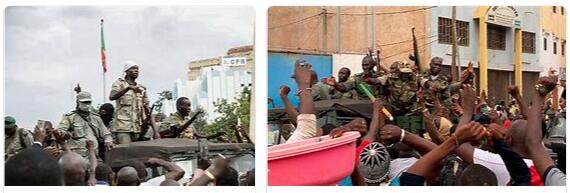ECONOMY: GENERAL INFORMATION
Mali is one of the poorest states in Africa, indeed in the world: GDP in 2008 was US $ 8,783 million and GDP per capita of US $ 657. Despite flourishing kingdoms and flourishing civilizations on its territory for centuries, in the 21st century Mali lost its strategic value as a land of passage between black and white Africa: it has scarce natural resources, an essentially desert territory (the waters of Niger are not adequately exploited) and its economic situation is aggravated by repeated natural disasters that have hit the country with obstinate frequency, especially in the seventies and eighties of the century. XX. . During the colonial period very little was implemented by the French colonial government in Mali; of a certain importance it was only, in the thirties of the century. XX, the creation of the Niger Authority, which was supposed to build numerous cotton and sugar cane plantations, but which at the practical act gave very little results. With the acquisition of independence, Mali’s economy underwent profound transformations in homage to a line of development that was at the same time African and socialist, aimed therefore at implementing a rapid process of economic decolonization. The state intervened in practically all sectors of the economy and commerce, the traditional authority of chieftains was abolished and a national currency was also created. It was a policy that alienated France and placed Mali in an extremely difficult economic situation despite the help of the Communist countries, especially China and the USSR. The discontent that swept through the country, especially in the merchant classes, and unstoppable inflation led in 1968 to a radical political-economic change with the rise to power of a more moderate government more open to collaboration with France and Western countries. Programs were launched to support economic growth, promote internal market liberalization, reduce heavy external debt, and numerous public enterprises were privatized. Obstacles to the development of Mali are still the lack of infrastructures and the continental nature of the country. To get out of this difficult situation, Mali has recourse to international aid, managing to enter into agreements with the reduce the heavy external debt and numerous public enterprises were privatized. Obstacles to the development of Mali are still the lack of infrastructures and the continental nature of the country. To get out of this difficult situation, Mali has recourse to international aid, managing to enter into agreements with the reduce the heavy external debt and numerous public enterprises were privatized. Obstacles to the development of Mali are still the lack of infrastructures and the continental nature of the country. To get out of this difficult situation, Mali has recourse to international aid, managing to enter into agreements with the IMF and with the World Bank. In 2005, members of the IMF and the World Bank canceled the country’s foreign debt. Visit fashionissupreme.com for Africa economy.
ECONOMY: AGRICULTURE, LIVESTOCK AND FISHING
A large part of the active population is employed in agriculture, a sector that participated for a good 37.2% (2007) in the formation of the national income; however, arable and arborescent crops cover only 4% of the territory and this is also due to the progressive, dramatic process of desertification of the extreme belt of the Sahel. In addition to the scarcity of good land, the production level is generally very low due to insufficient and in any case highly irregular rainfall; then there are delays and errors due to the same archaic organization of agricultural activity. At the end of the nineties of the twentieth century, the country managed to satisfy the internal needs with a series of good harvests achieved thanks to the improvement of irrigation and cultivation techniques. As for traditional crops, destined for local food, millet and sorghum prevail, while rice, grown in the irrigated areas of the Niger delta, is of recent introduction, as is maize. Cassava and batata are also important for local nutrition, as well as certain vegetables and legumes. Cotton, also grown in the dry soils of southern Mali, is the main item of Malian exports; peanut, tea, sugar cane follow. Other products intended for trade are tobacco, also cultivated in the dry soils of southern Mali, it is the main item of Malian exports; peanut, tea, sugar cane follow. Other products intended for trade are tobacco, also cultivated in the dry soils of southern Mali, it is the main item of Malian exports; peanut, tea, sugar cane follow. Other products intended for trade are tobacco, shea or “butter tree” (from whose seeds a kind of butter is obtained), kapok etc. § Forests yielded almost 5 and a half million m 3 in 2005 of timber, as well as good quantities of gum arabic, intended for export. § Mali has one of the most conspicuous livestock stocks in West Africa, even if recurrent droughts are killing herds and weakening the surviving livestock; there is also a lack of sufficient slaughtering and refrigeration facilities to allow for a more commercial approach to livestock farming; finally, breeding is rarely associated with crops, so that herds and flocks are forced to go through very long and exhausting transhumances to obtain sufficient fodder. Cattle clearly prevail, largely owned by the Fulbe and other pastoral populations that move along the Niger. There are also numerous sheep and goats, especially widespread in the Sahel, where however the conditions are extremely precarious, enough to make the deaths of livestock frequent; there are also poultry, horses and camels. § Another important resource is fishing, practiced in Niger mainly by the bozo; the fish is then dried or smoked and to some extent exported to neighboring countries. The catch consists of manatees and carp.
